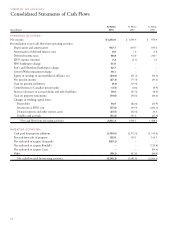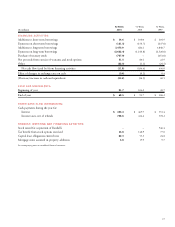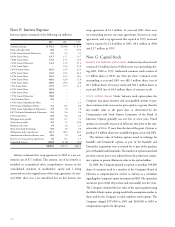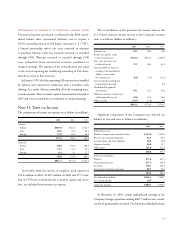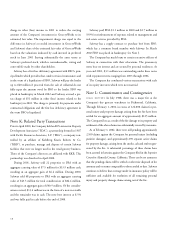Safeway 2001 Annual Report Download - page 30
Download and view the complete annual report
Please find page 30 of the 2001 Safeway annual report below. You can navigate through the pages in the report by either clicking on the pages listed below, or by using the keyword search tool below to find specific information within the annual report.
28
STOCK-BASED COMPENSATION Safeway accounts for stock-
based awards to employees using the intrinsic value method in
accordance with Accounting Principles Board Opinion No. 25,
“Accounting for Stock Issued to Employees.” The disclosure
requirements of SFAS No. 123, “Accounting for Stock-Based
Compensation,” are set forth in Note G.
NEW ACCOUNTING STANDARDS In June 2001, the Financial
Accounting Standards Board issued SFAS No. 141, “Business
Combinations,” and SFAS No.142, “Goodwill and Other
Intangible Assets.” SFAS No. 141 requires that all business com-
binations initiated after June 30, 2001 be accounted for under
the purchase method and addresses the initial recognition and
measurement of goodwill and other intangible assets acquired in
a business combination. In the event Safeway acquires goodwill
in the future it will not be amortized. SFAS No. 142 addresses
the initial recognition and measurement of intangible assets
acquired outside of a business combination and the accounting
for goodwill and other intangible assets subsequent to their
acquisition. SFAS No. 142 provides that intangible assets with
finite useful lives be amortized and that goodwill and intangible
assets with indefinite lives will not be amortized, but will rather
be tested at least annually for impairment. Under the provisions
of SFAS No. 142, any impairment loss identified upon adoption
of this standard is recognized as a cumulative effect of a change
in accounting principle. Any impairment loss incurred subse-
quent to initial adoption of SFAS No. 142 is recorded as a charge
to current period earnings. SFAS No. 142 was effective for
Safeway beginning on December 30, 2001 and, since that time,
Safeway has stopped amortizing goodwill. Goodwill was $5.1
billion at year-end 2001 and $4.7 billion at year-end 2000.
Goodwill amortization was $140.4 million in 2001, $126.2 mil-
lion in 2000 and $101.4 million in 1999. Other than the elimi-
nation of goodwill amortization, the Company has not yet
determined the effect that adoption of SFAS No. 142 will have
on its financial statements.
In October 2001, the Financial Accounting Standards Board
issued SFAS No. 144, “Accounting for the Impairment or Disposal
of Long-Lived Assets.” SFAS No. 144, which replaces SFAS
No. 121 and APB No. 30, became effective for Safeway on
December 30, 2001. Adoption of this standard did not have a
material effect on the Company’s financial statements.
Emerging Issues Task Force (“EITF”) Issue Nos. 00-14,
“Accounting for Certain Sales Incentives”; 00-22, “Accounting for
‘Points’ and Other Time-Based or Volume-Based Sales and
Incentive Offers, and Offers for Free Products or Services to be
Delivered in the Future”; and 00-25, “Vendor Income Statement
Characterization of Consideration from a Vendor to a Retailer,”
became effective for Safeway beginning in the first quarter of 2002.
These Issues address the appropriate accounting for certain vendor
contracts and loyalty programs. Adoption of these issues did not
have a material effect on the Company’s financial statements.
Note B: Acquisitions
The following unaudited pro forma combined summary financial
information is based on the historical consolidated results of oper-
ations of Safeway, Carrs, Randall’s and Genuardi’s as if the acqui-
sitions had occurred, all related debt was assumed and related
goodwill was recorded, at the beginning of 1999. The information
for 2001 is not materially different than actual results and is not
included. This pro forma financial information is presented for
informational purposes only and may not be indicative of what
the actual consolidated results of operations would have been if
the acquisitions had been effective as of the beginning of 1999.
Pro forma adjustments were applied to the respective historical
financial statements to account for the acquisitions as purchases.
Under purchase accounting, the purchase price is allocated to
acquired assets and liabilities based on their estimated fair values at
the date of acquisition, and any excess is allocated to goodwill.
Pro Forma
(in millions, except per-share amounts) 2000 1999
Sales $ 32,904.1 $ 31,595.9
Net income $ 1,100.9 $ 954.5
Diluted earnings per share $2.15$1.81






